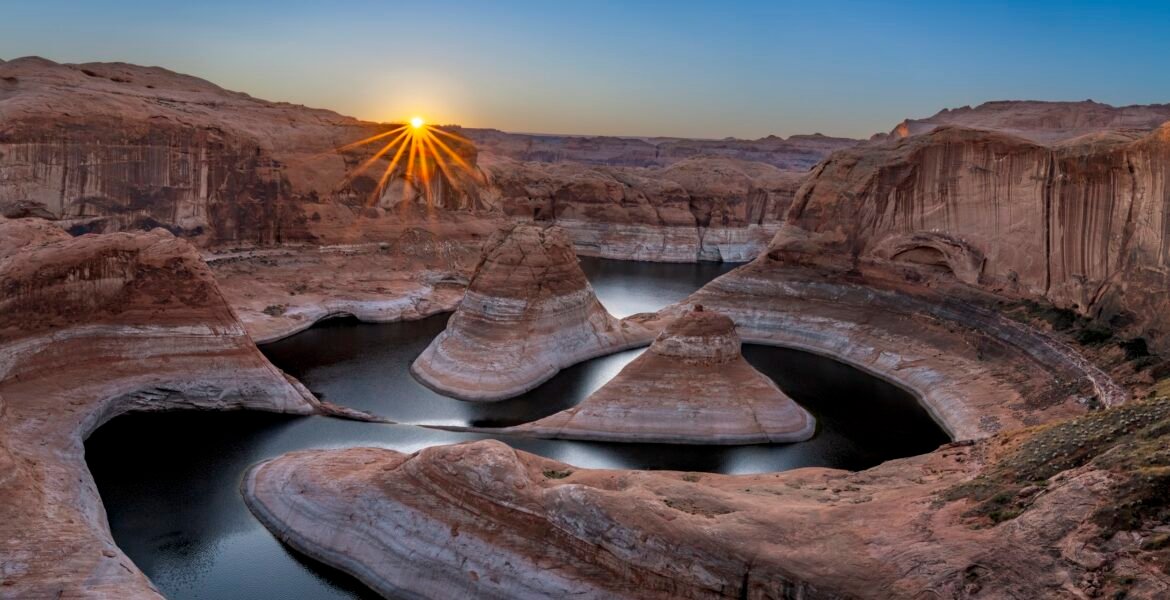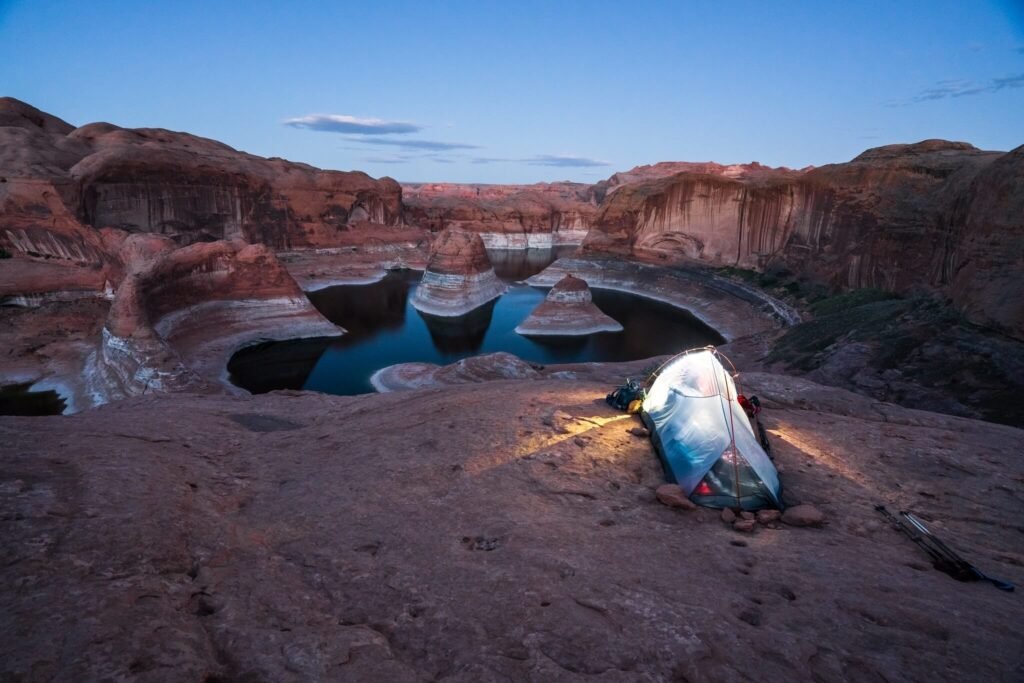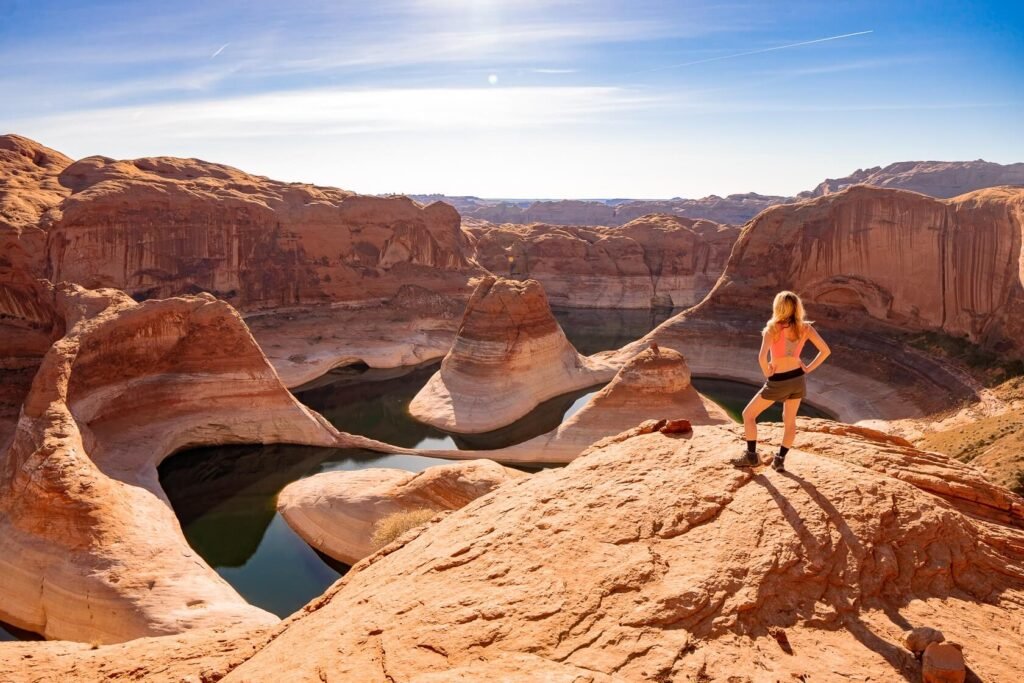
The Ultimate Guide to Reflection Canyon: Nature’s Hidden Masterpiece
Introduction to Reflection Canyon
Tucked away in the rugged heart of Utah’s canyon country lies a secret that only the boldest adventurers know about—Reflection Canyon. This hidden gem, carved out by the relentless power of the Colorado River, remains one of the most awe-inspiring yet least-visited landscapes in the American Southwest. With its winding water channels, majestic red rock formations, and near-perfect mirrored reflections during calm mornings, this natural amphitheater delivers a visual feast that feels otherworldly. Unlike popular destinations that are overwhelmed by crowds, Reflection Canyon offers an untouched, soul-stirring escape into pure wilderness. It’s not just a place you see; it’s a place you feel.
Geography and Location
Where is Reflection Canyon Located?
Reflection Canyon is located within the Glen Canyon National Recreation Area in southeastern Utah. It’s part of a vast and desolate region dominated by canyons, mesas, and buttes sculpted by time. Geographically, it hugs the edges of Lake Powell, which straddles the Utah-Arizona border. While it’s technically a part of the lake, it looks and feels worlds apart from the boating meccas found elsewhere along the shoreline. This part of the canyon is remote—there are no paved roads, signs, or visitor centers to guide you. That’s part of its charm and challenge.
Getting There: The Nearest City and Access Points
The nearest city with basic services is Escalante, a small gateway town that serves as a launch point for many adventures in Grand Staircase-Escalante National Monument. To access Reflection Canyon, you’ll have to drive roughly 50 miles down Hole-in-the-Rock Road, a rough, washboard-ridden dirt road. At the end of this road, your vehicle goes no further. From here, it’s all on foot—an epic journey through open desert that demands preparation, perseverance, and a good dose of determination.
GPS Coordinates and Mapping Tips
Navigating to Reflection Canyon is not straightforward. There is no official, maintained trail, and cell service is nonexistent in the backcountry. Your best bet is to use a combination of GPS coordinates, topographical maps, and satellite imagery. The coordinates to aim for are 37.0955° N, 111.1974° W. Many seasoned hikers use offline apps like Gaia GPS or AllTrails+ for navigation, but carrying a physical map and compass as backup is a smart move. It’s all part of the adventure—you’re navigating one of the wildest places left in the Lower 48.

History and Formation
Geological Background
Reflection Canyon is part of the larger Colorado Plateau, a vast geological wonderland that spans across Utah, Arizona, Colorado, and New Mexico. This area is composed mainly of Navajo Sandstone, a type of ancient dune-derived rock that forms the sweeping curves and sheer cliffs seen in the region. Over hundreds of millions of years, wind and water erosion have slowly chiseled away at these layers, sculpting the dramatic formations that define the canyon today. What you see at Reflection Canyon is not just a pretty picture—it’s a visual timeline of Earth’s ancient history.
The Power of the Colorado River
The Colorado River is the master artist behind Reflection Canyon. Over millennia, this mighty river has cut deeply into the sandstone layers, creating winding bends, deep alcoves, and wide basins that hold water like polished bowls. When Lake Powell was created with the construction of the Glen Canyon Dam in the 1960s, parts of the Colorado River valley, including Reflection Canyon, were submerged under rising waters. During low water levels, however, the canyon’s true form is revealed—sharp ridges encircle the water, creating that iconic reflective “S” shape seen in stunning photographs.
Erosion, Time, and Beauty
The natural beauty of Reflection Canyon is the result of relentless geological patience. This isn’t a place built overnight; it’s a product of millions of years of erosion. Flash floods, sedimentation, freeze-thaw cycles, and prevailing winds all worked together to shape this masterpiece. Unlike tourist-heavy parks with guardrails and paths, Reflection Canyon remains wild and untouched—a true canvas of Earth’s raw and ancient processes.
Best Time to Visit
Seasonal Considerations
Planning a trip to Reflection Canyon requires an understanding of seasonal extremes. Spring (April–June) and fall (September–October) are widely considered the best times to go. During these months, daytime temperatures are manageable, and nights are cool. Avoid visiting in the peak of summer, when temperatures can soar well above 100°F (38°C), turning your hike into a dangerous ordeal. Winter, while less crowded, brings snow and freezing temperatures, complicating travel on Hole-in-the-Rock Road and adding hazards to the hike.
Ideal Weather Conditions
The perfect day for visiting Reflection Canyon is dry, cool, and clear. Blue skies and calm winds help produce the stunning mirrored reflections the canyon is famous for. Monsoon season (typically July through early September) poses a significant risk of flash flooding, especially in the slickrock washes you must cross to reach the viewpoint. Always check local weather reports before heading out and never underestimate desert storms—they appear quickly and can be life-threatening.
Sunrise and Sunset Views
Golden hour transforms Reflection Canyon into something truly surreal. At sunrise, the rising light creeps down the canyon walls, painting everything in shades of gold and crimson. Sunset is equally spectacular, with alpenglow effects that make the sandstone seem to radiate warmth. Photographers and nature lovers alike cherish these times for the unmatched serenity and magical light they offer.
How to Get to Reflection Canyon
Hiking Routes
The hike to Reflection Canyon is not for the faint of heart. Depending on your route, it spans 16 to 20 miles round trip, entirely off-trail. There’s no signage, no maintained path—just wide desert expanses, slickrock ridges, and deep washes. Most hikers begin at the end of Hole-in-the-Rock Road near the historic Hole-in-the-Rock Expedition marker. From there, you’ll navigate by GPS, bushwhack across open desert, and follow a general trajectory southeast until you reach the overlook.
The Escalante Route Overview
One of the more popular GPS-guided paths is known as the Escalante Route, not to be confused with the Escalante River Trail. This route guides you over open terrain, where landmarks such as distant mesas and ridge lines become your companions. The terrain is mostly rolling slickrock, with occasional sandy patches and shallow canyons. Navigation is key—losing your bearings out here can have serious consequences.
Planning a Backpacking Trip
Given the distance and difficulty, many hikers opt to turn the trip into a 2-3 day backpacking adventure. This allows for a more relaxed pace and a night under the stars near the canyon rim. If you plan to camp, you must follow Leave No Trace principles and be prepared to carry all your own water—there are no natural sources near the viewpoint. Campsites are primitive but spectacular, offering unobstructed views of the canyon and its surroundings.
Permits and Regulations
Currently, no permits are required specifically for hiking to Reflection Canyon. However, because the trail begins on land managed by the Bureau of Land Management (BLM), it’s wise to check in with local ranger stations or online resources for any seasonal restrictions or updates. Fires are prohibited, and all human waste must be packed out. The remoteness of the area means that everyone has a personal responsibility to protect it.
Photography at Reflection Canyon
Why It’s a Photographer’s Dream
Reflection Canyon is a paradise for photographers. Its swirling curves, dramatic cliffs, and vivid sandstone hues create a natural composition that looks like it was painted by the gods. During calm weather, the still waters of Lake Powell mirror the sky and surrounding canyon walls, creating a symmetrical scene that seems almost surreal. Every angle offers a unique perspective—no two shots ever look the same, especially with the constantly shifting light.

Whether you’re a professional photographer or a casual traveler with a smartphone, the visual impact of this place is undeniable. The sense of scale, solitude, and raw beauty translates through the lens in a way that few other places can match. Plus, the absence of crowds gives you the luxury of taking your time to get the perfect shot without distractions.
Best Camera Settings and Equipment
For those carrying a DSLR or mirrorless camera, shooting during golden hour (the hour after sunrise or before sunset) yields the richest results. Use a wide-angle lens (14–24mm) to capture the full breadth of the canyon’s curves. A polarizing filter helps reduce glare on the water and deepen the blue of the sky, while a neutral density (ND) filter can allow for longer exposures, smoothing out any surface ripples in the water.
Tripods are a must for low-light situations and long exposures, especially if you’re shooting star trails or the Milky Way at night. Bracketing exposures for HDR (High Dynamic Range) images can also help preserve details in both shadows and highlights. Don’t forget extra batteries—there are no charging stations in the wilderness.
Tips for Sunrise and Sunset Shots
To capture those epic shots you’ve probably seen online, plan to arrive at the canyon well before sunrise or stay past sunset. The light during these times casts long shadows and enhances the rich, warm tones of the sandstone. Bring a headlamp for hiking in or out in the dark and allow extra time for setting up your gear.
Be aware of your shadow’s direction when composing shots—especially during sunrise, when it’s easy to accidentally photobomb your own frame. Try a few vertical compositions as well; they often accentuate the canyon’s winding curves and give a sense of scale that’s lost in wide horizontal shots.
Camping Near Reflection Canyon
Can You Camp Nearby?
Yes, camping near Reflection Canyon is not only possible, it’s encouraged for those making the trek. Because of the hike’s intensity and length, staying overnight allows for a more relaxed and immersive experience. You’ll not only avoid hiking during the hottest part of the day but also get to witness the canyon in its most dramatic light—dusk and dawn.
There are no established campsites, but dispersed camping is allowed in the general area. Most people set up camp on the rim overlooking the canyon, offering jaw-dropping views just steps from their tents. Watching the stars emerge over the canyon is a once-in-a-lifetime experience that makes the trek completely worth it.
Camping Gear Essentials
If you’re camping out here, you need to be completely self-sufficient. Bring a lightweight, four-season tent capable of handling strong winds, and a sleeping bag rated for the desert’s temperature extremes. A foam sleeping pad can provide insulation from the rocky ground. Make sure your backpack has enough capacity for food, shelter, and at least a gallon of water per person, per day—there are no water sources at the site.
Also essential: a water filtration system, emergency beacon or GPS communicator, headlamp, map, and first-aid kit. Don’t forget sunscreen, sunglasses, and a wide-brimmed hat for daytime protection. Everything you pack in must be packed out—including all trash and human waste. Bring waste bags and practice Leave No Trace ethics.
Safety and Precautions
Challenges of the Hike
Hiking to Reflection Canyon is not your average weekend stroll. It’s a physically demanding, off-trail expedition through rugged and remote terrain. There are no trail markers or water stops. Navigation requires GPS, and the hike demands endurance. Heat exhaustion, dehydration, and disorientation are common risks. You’ll be far from help, so turning back at the first sign of trouble is crucial.
Water, Heat, and Survival
Desert hiking comes with serious risks, especially during summer months. The lack of shade, high temperatures, and absence of water sources means heat stroke and dehydration are major concerns. Carry at least 1.5 gallons of water per person, and drink small sips regularly rather than waiting until you’re thirsty. Electrolyte tablets or drinks can help replenish what you sweat out.
Emergency Preparedness
In this isolated region, help can be hours or even days away. Let someone know your exact itinerary before heading out, and always carry a satellite communicator, such as a Garmin inReach or SPOT device. Cell phones are essentially useless out here. If something goes wrong, these devices could be the difference between life and death.
Nearby Attractions
Hole-in-the-Rock Road Sites
If you’ve made it all the way down Hole-in-the-Rock Road, don’t miss some of its other incredible attractions. Devils Garden, with its whimsical hoodoos and natural arches, is a great stop for photos and short hikes. Peek-a-Boo and Spooky Slot Canyons offer thrilling slot canyon experiences just off the main road, perfect for those looking to add adventure to their trip.
Grand Staircase-Escalante National Monument
Reflection Canyon sits just outside this vast monument, which offers a lifetime’s worth of hiking and exploring. From the towering walls of Coyote Gulch to the lush green oasis of Calf Creek Falls, there’s no shortage of jaw-dropping landscapes nearby. You can easily spend a week exploring this underrated part of Utah.
Conclusion: Is Reflection Canyon Worth It?
Absolutely—if you’re up for the challenge. Reflection Canyon is not for everyone. It’s wild, remote, and physically demanding. But for those willing to put in the effort, it offers an unforgettable experience of solitude, beauty, and raw nature at its finest. Standing at the canyon rim as the light dances off the water, you realize something: this isn’t just a hike. It’s a pilgrimage to one of Earth’s most exquisite corners. The journey humbles you, tests you, and rewards you in ways few places can.
FAQs
1. Do I need a permit to visit Reflection Canyon?
No special permit is required, but it’s a good idea to check with local BLM offices for any seasonal restrictions or updates.
2. How long does the hike to Reflection Canyon take?
Most hikers complete the trek in 8–12 hours round trip, or split it into a 2-day backpacking trip.
3. Can I bring my dog on the hike?
Technically yes, but it’s not recommended. The terrain is harsh, hot, and lacks water—conditions can be dangerous for pets.
4. Is there any cell service at Reflection Canyon?
No. You’ll be completely off-grid. Bring a GPS communicator or emergency beacon for safety.
5. Can I visit Reflection Canyon with a tour guide?
Most people go independently, but some backpacking guides and outfitters in the Escalante area offer guided trips to Reflection Canyon.

Leave a Reply